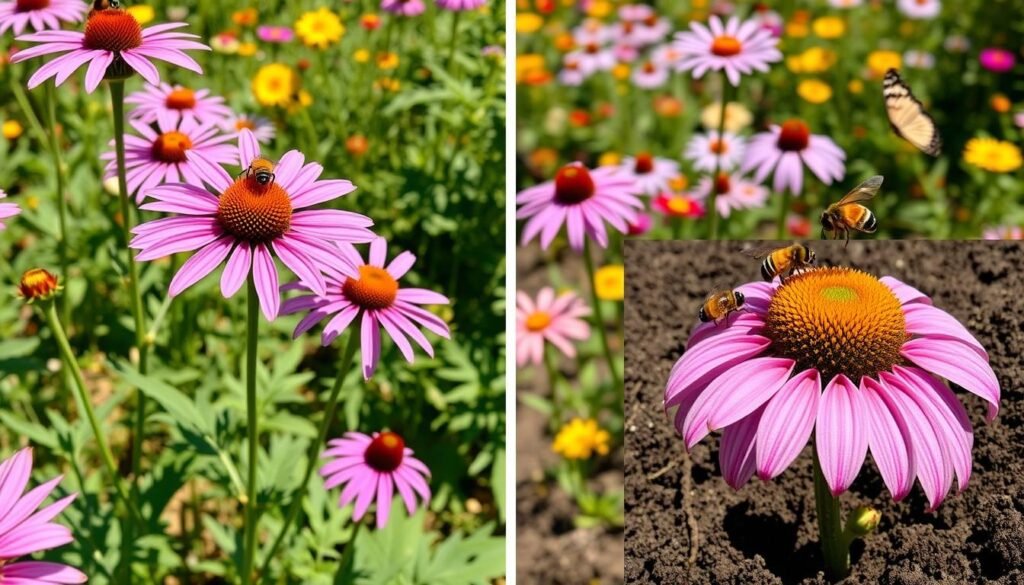Taking stem cuttings from purple coneflowers might not work well. It’s better to use division or seeds for growing new plants.
But I wonder, can you take a cutting from a purple coneflower? This question leads me to explore Echinacea propagation and different plant methods. Let’s discover how to grow these beautiful perennials in our gardens.
Key Takeaways
- Echinacea, especially purple coneflowers, are beautiful and resilient additions to any garden.
- Propagation can be achieved through cuttings, division, or seeds, creating opportunities to expand your floral display.
- Understanding your soil and sunlight conditions is vital for successful Echinacea growth.
- Purple coneflowers bloom mid-summer through frost, attracting various pollinators.
- These flowers come in an array of colors beyond purple, enhancing visual interest.
Table of Contents
The Beauty of Purple Coneflowers in the Garden
Purple coneflowers, or Echinacea purpurea, make any garden look amazing. Their bright, daisy-like flowers welcome visitors. The strong stems add height, making them hard to miss.
These plants are great for attracting bees and butterflies. They help keep the garden healthy. Plus, they grow back easily, making gardening easy.
Purple coneflowers love sunlight and well-drained soil. They grow up to 1.5 meters tall and spread about 60 cm. Planting them with other flowers keeps your garden looking good all year.
For these plants to do well, they need regular care. They need lots of sunlight and about an inch of water a week. This care helps them grow strong and bloom every spring.
If you want to add these flowers to your garden, learn how to grow them. You can use division, seeds, or root cuttings. For more info, check out how to propagate coneflowers.
Understanding Echinacea: A Brief Overview
Echinacea, also known as coneflowers, has 11 species native to North America. Echinacea purpurea, or the purple coneflower, is very popular. It grows well in many places in the eastern United States.
The different types of coneflower are amazing, with colors like bright pink, white, and yellow. These colors make gardens look beautiful. They also attract birds, butterflies, and bees.
Echinacea has a long history. Native Americans used its roots for medicine. Today, we use Echinacea in cough drops and to boost our immune system. It’s beautiful and helps our health and wildlife.
Some Echinacea species are special. For example, E. purpurea has wide petals and likes wet soil. But, some are hard to transplant because of their deep roots. Hybrid plants, like those made from E. paradoxa and E. purpurea, have many colors and traits.
New plants like ‘Katie Saul’ and ‘Tangerine Dream’ are being made. They have new smells and colors. It’s important to make sure the soil drains well, as Echinacea likes dry soil. This helps them grow well in gardens across North America.
Benefits of Growing Purple Coneflowers

Purple coneflowers are great for gardeners wanting to improve their outdoor areas. They need little care, making them perfect for all gardeners. These perennial flowers bloom from mid-summer to fall, adding color to your garden.
These plants also love dry soil and need little water. This makes them good for saving water and is eco-friendly. Watching them grow, I see how they make my garden better for the planet and add beauty.
Purple coneflowers attract bees and butterflies, helping local ecosystems. By planting them, I help support biodiversity. They not only make my garden look good but also help pollinate our food.
Cones also make great cut flowers, lasting long in vases. With all these gardening benefits, it’s no wonder they’re popular. For tips on growing beautiful flowers like these, check out this guide.
Methods of Propagation for Purple Coneflowers
Understanding how to propagate purple coneflowers is key. There are three main ways: division, rooting from cuttings, and growing from seeds. Each method has its own benefits and needs.
Division is the top choice for gardeners. It keeps plants healthy and grows more. Do it in spring or late fall. Wait for new growth, then use a sharp spade to split the roots.
After dividing, replant in soil that drains well. This stops water from pooling.
Timing is crucial for coneflower growth. Root cuttings are the most challenging but rewarding. Take them in spring. Seeds are harvested in late summer or early fall. They need a cold period to grow well.
Here’s a summary table of the propagation methods I find useful:
| Method | Timing | Requirements | Conditions |
|---|---|---|---|
| Division | Spring or late fall | Sharp spade, well-drained soil | 6-8 hours sunlight |
| Root Cuttings | Spring | Sharp shears, patience | Drought tolerant once established |
| Seeds | Late summer or fall | Chilling period, suitable depth | 1/2 inch deep, 10-14 days germination |
For success, water and sun are key after planting. Established plants need about an inch of water weekly. They are very drought-tolerant once settled. Knowing these methods leads to a beautiful coneflower garden that attracts wildlife.
Can You Take a Cutting from a Purple Coneflower?
Many gardeners wonder if they can take cuttings from Echinacea. Propagating these flowers can be done in several ways. But, knowing the best method can really help.
Coneflower cuttings might not be as easy as other plants. Root cuttings usually work best. But, let’s look at the different cutting types.
Types of Cuttings: What Works Best?
Choosing the right cutting type is key for Echinacea propagation. Here’s what you need to know:
- Stem Cuttings: These can be tough for coneflower cuttings. Success rates are often lower than other methods.
- Root Cuttings: Root cuttings are a better choice. Take them in the spring for the best growth.
- Seeds: Self-seeding is a natural way. Collect seed heads in late summer for more blooms.
Timing and technique are crucial for healthy new plants. The vigor of cultivated varieties can differ from wild ones. Root cuttings are usually the most reliable for Echinacea propagation.
How to Propagate Coneflowers Using Division
Propagating purple coneflowers through propagation by division is very effective. It makes sure new plants are strong. This method works best in spring or late fall when plants aren’t blooming.
Before starting, I water the coneflower plants a day before. This makes the soil easier to work with. Then, I dig up the plant carefully to avoid harming the roots.
After digging, I shake off extra soil to see the rhizomes. I look for natural breaks in the rhizomes. Using a sharp tool, I split the plant into sections. Each section should have healthy roots and at least one stem.
Now, I replant the sections in good soil. They need 6 to 8 hours of sunlight each day. I water them about one inch per week to help the roots grow. Keeping the soil pH between 6 to 7 is also important for their health.
With the right care, these new plants will grow well. They will make my garden even more beautiful.
Growing from Seed: Another Option for Propagation
Growing coneflowers from seed is a fun way to add these colorful plants to your garden. It takes longer than division or cuttings, but it’s worth it. You can try different Echinacea seeds and hybrids.
I collect seeds from mature plants in late summer or early fall. This is when they are ready to harvest. I can plant them outside in the fall or wait until spring. Fall planting helps seeds germinate better.
For seeds to grow well, they need the right conditions. I plant them in soil that drains well and gets full sun. Echinacea seeds need at least 6 hours of sunlight a day. Water them regularly, about 1 to 2 inches a week, to help them grow strong.
- Seed Propagation Methods: Echinacea seeds stay good for at least 7 years. This makes planning easier.
- Soil pH: These plants like a pH of 6 to 7. This helps them get nutrients.
- Drought Tolerance: Once they’re grown, purple coneflowers need less water.
Using seeds to grow plants makes gardening more fun. It also lets me create new and different plants for my garden.
Optimal Conditions for Successful Coneflower Growth
To grow purple coneflowers well, knowing their needs is key. They love full sun, needing at least six hours a day. While they can handle some shade, more sun means brighter blooms.
The soil should drain well and be slightly acidic. Adding organic stuff helps make the soil better for plants.
These flowers are tough and don’t need much water. They need about an inch of water each week. If it rains a lot, you might not need to water them.
Using drip irrigation is a good idea. It waters the roots directly, making plants stronger.
Planting coneflower seeds is rewarding. Seeds for Echinacea purpurea don’t need special treatment. Plant them in spring after the frost is gone. They need sunlight to grow, and it takes two to three weeks for them to sprout.
For starting seeds, know that most echinacea seeds need cold, moist conditions for eight to 12 weeks to grow.
Space plants 12 to 18 inches apart. This lets them grow and breathe, helping avoid diseases. They don’t usually need fertilizer, but a special one can help with small flowers. Cutting off old flowers encourages new ones to grow.
After they bloom, cut the plants back by a third. This helps them get ready for next year’s growth. Following these steps makes for a beautiful garden with these flowers.
| Growing Requirement | Details |
|---|---|
| Sunlight | Full sun (at least 6 hours) or partial shade |
| Soil Type | Well-drained, neutral to slightly acidic pH |
| Watering | 1 inch per week; use drip irrigation |
| Seed Germination | 2-3 weeks at 70°F to 75°F |
| Spacing | 12 to 18 inches apart |
| Fertilization | High phosphorus fertilizer if necessary |
Gardening Tips for Caring for Your Coneflowers

Caring for purple coneflowers makes them more beautiful and keeps them blooming longer. These plants do well in USDA zones 4 through 9. They are perfect for many gardens. Here are key tips for keeping coneflowers healthy.
- Watering: I water my coneflowers every other day when they’re new. Later, I water them once a week.
- Sunlight: Coneflowers need at least 6 hours of sunlight daily. A sunny spot helps them grow and bloom better.
- Fertilization: A compost top dressing around the plant boosts blooming. It gives them the nutrients for bright flowers.
- Deadheading: I remove spent blooms often. This keeps the plant looking good and encourages more blooms.
- Pest Management: Watching for pests like wasps and leafhoppers helps avoid infestations. Soapy water is a good, green way to keep them away.
Keeping coneflowers healthy is rewarding. They are easy to care for but need some attention, especially when they’re young. By following these tips, my garden stays colorful and vibrant.
Conclusion
Propagating purple coneflowers is a fun and rewarding hobby. It lets gardeners enjoy these beautiful plants for many years. Using different methods like cuttings, division, and seeds can make your garden grow strong and healthy.
Knowing that Echinacea can live for 5 to 15 years or more makes it even more exciting. This means their initial cost is worth it.
By following the tips in this article, I’ve seen how purple coneflowers can make my garden look amazing. For more tips, check out this guide on Echinacea.
Gardening is not just about growing flowers. It’s also about creating a lively ecosystem. Growing Echinacea attracts pollinators and makes your garden look stunning. I’m excited to keep learning and enjoying the beauty of these plants.




